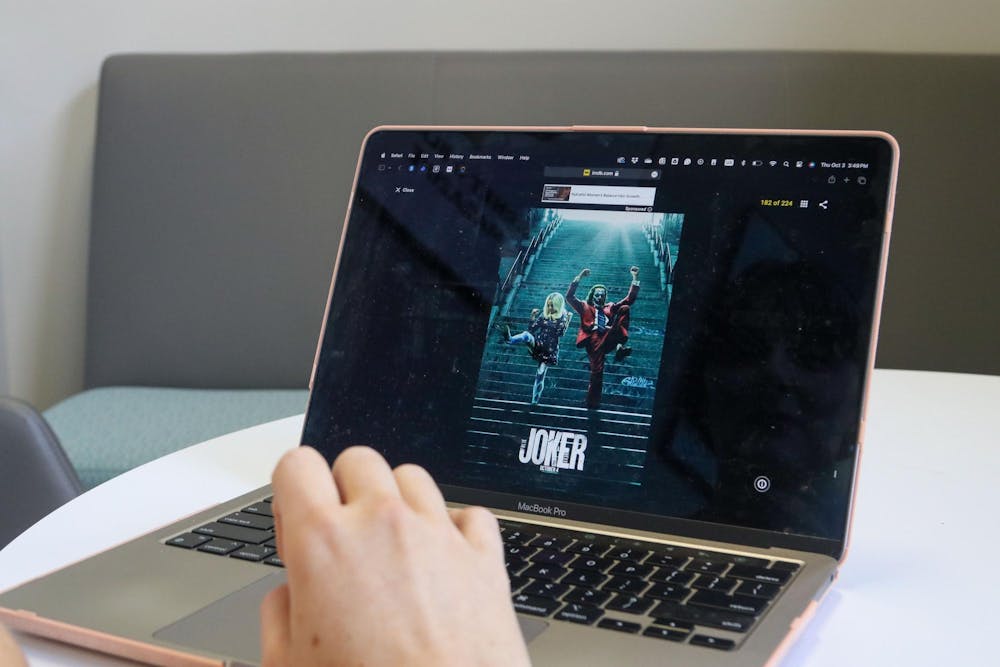Movie: Joker: Folie à Deux
Release Date: Oct. 4, 2024
Director: Todd Phillips
Runtime: 2 hours, 19 minutes
Genre: Drama/Musical
Oscar Potential: Supporting Actress, Cinematography, Production Design, Costume Design, Makeup and Hairstyling
Rating: C-

“Joker: Folie à Deux” will divide audiences with the swings it takes to differentiate itself from the original, which was done by utilizing the musical genre. Opening with a Looney Tunes-style animated sequence, this film lets fans of the original know that they are walking into a completely different experience. The light-hearted opening shows Joker battling with his shadow for control of his life, a theme that will be relevant throughout the film as it dives into Joker's psyche and his struggle with mental illness.
Following this opening sequence, the film reintroduces us to Arthur Fleck / Joker (Joaquin Phoenix) in prison two years after the events of the first film. Attempting to reach a successful insanity plea, he tries his best to live as Arthur Fleck instead of Joker. While in prison, Arthur gets signed up for a singing program where he meets Harleen “Lee” Quinzel / Harley Quinn (Lady Gaga). As their relationship develops, Harleen sparks a shift for Arthur to go back to his Joker personality.
As the story develops, the internal and external conflict relating to Arthur’s personalities become more apparent. Arthur is fighting for control over his life while outside characters try to manipulate him for their benefit. As his mental health chips away, it becomes clear that the Joker is not a separate identity of Arthur's — he is just a broken man who responds to conflict in violent ways due to his painful childhood. This idea signifies the film's main message that we need to accept the mentally ill as who they are in society and help them in every way possible instead of alienating and exploiting them. While these themes of mental illness and the need to accept damaged people like Arthur are important, the film’s narrative does not do these messages justice.
The emergence of Harley and Arthur's relationship sparks this conflict and also introduces us to the musical elements. The heavy reliance on song is one way these messages are negatively impacted. There are moments where the use of song helps accentuate the film's themes of control and mental illness, but many of these sequences feel like filler and end up drawing out the runtime. If all the musical numbers contributed to the story significantly, the sheer number of songs would feel less overbearing to the audience.
Another way the film's themes are negatively impacted is through the pacing. The film has many extended courtroom drama sequences because the narrative centers around Arthur’s criminal trial for murdering five people. The pacing in these sequences slows to that of a glacier as it focuses too long on these moments, making the whole process feel repetitive and unnecessary. As Harley pushes Arthur away from his lawyers, who repress many of his violent thoughts, the themes around control of his mental illness become compelling. However, the road to get to these conflicts through the trial feels flat and unrewarding.
Despite these prominent issues surrounding how the narrative is executed, there is still much to admire beyond the themes of mental health. Lawrence Sher's cinematography is visually striking as the colors and lights dance around the frame like our main characters. The set design and costumes are dazzling, pleasing to the eyes and keeping the audience engaged even if the narrative feels stale. After winning an Academy Award for Best Original Score for “Joker,” Hildur Guðnadóttir returns as the sequel’s composer. As was the case with the original, Guðnadóttir’s music successfully haunts each frame.
Reprising his Academy Award-winning role as Arthur Fleck / Joker, Joaquin Phoenix delivers another pitch-perfect performance, channeling the tragic pain of this iteration of the character. Phoenix once again feels creepy, funny and heartbreaking all at once in this role. Lady Gaga is also a welcome addition to the fray as Harley Quinn. Gaga brings a certain darkness to the role, where the audience never knows her true intentions until far into the film. Being able to walk this tightrope shows her growing skills as an actress. The musical numbers also benefit from her commanding vocal and physical presence. While her role could have been more prominent, she added a spark to the material she was given.
While many elements are sure to entertain audiences, and the stylistic swings are captivating in concept, “Joker: Folie à Deux” ultimately underwhelms. Despite meaningful messages surrounding mental health and acceptance, an arresting visual style and excellent performances from Phoenix and Gaga, it is unable to execute the narrative in a rewarding fashion for its audience.

